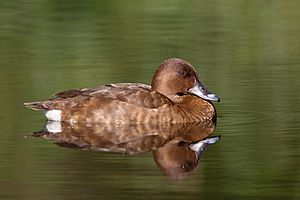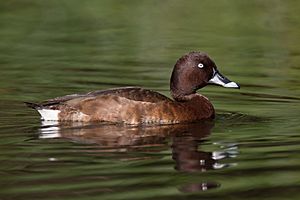Hardhead facts for kids
Quick facts for kids Hardhead |
|
|---|---|
 |
|
| Female | |
 |
|
| Male | |
| Conservation status | |
| Scientific classification | |
| Genus: |
Aythya
|
| Species: |
australis
|
| Subspecies | |
|
|
| Synonyms | |
|
Nyroca australis Eyton, 1838 |
|
The hardhead (Aythya australis), also called the white-eyed duck, is a special kind of diving duck. It's the only true diving duck you'll find in Australia!
Its name "hardhead" doesn't mean its head is super tough. Instead, early taxidermists (people who prepare animal bodies) found it hard to work with the duck's head. That's how it got its unique name!
Hardheads are common in south-east Australia. You'll often see them in places like the Murray-Darling Basin and wet areas near the coast. They like to move around a bit, especially when there's a drought. Sometimes, they even fly to places like New Guinea, New Zealand, and other Pacific islands. They might even stay there for a while and have ducklings!
Contents
What Do Hardheads Look Like?
Hardheads are small ducks, usually about 45 cm long, but some can reach 60 cm. They look more rounded than most other ducks.
Both male and female hardheads are a chocolate-brown color on top. Their sides are a reddish-brown, and their undersides are white. You might not always see the white if the duck is in the water. The edges and almost the entire underside of their wings are also white.
You can tell the males and females apart by their eyes. Males have bright white eyes, which is why they are sometimes called "white-eyed ducks." Females have brown eyes.
Where Do Hardheads Live?
Hardheads love big lakes, swamps, and rivers. They prefer deep, still water. However, you can also spot them in smaller streams, flooded grasslands, and shallow pools.
They usually stay away from coastal waters. Hardheads rarely come onto land and never perch in trees. They are truly water birds!
How Do Hardheads Eat?
Like other ducks in the pochard group, hardheads find their food by diving deep underwater. They can stay submerged for up to a minute at a time!
They slip into the water very smoothly, almost without a ripple. They just lower their heads and push off with their strong, webbed feet. Hardheads eat many different small water creatures. They also munch on water weeds to complete their diet.
Hardhead Sounds
Hardheads are usually quiet ducks. However, males do make a soft, wheezy whistle and a 'whirr' sound. Females have a louder call that sounds like a rattling 'gaark'.
Hardhead Conservation Status
The hardhead is found across a very large area. Because of this, it is listed as "Least Concern" on the IUCN Red List of Threatened Species. This means that experts believe it is not currently at risk of disappearing.
Images for kids
See also
 In Spanish: Porrón australiano para niños
In Spanish: Porrón australiano para niños
- Mylopharodon conocephalus, a freshwater fish also known as the hardhead. This fish lives in California.




